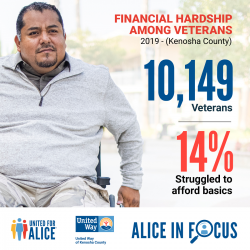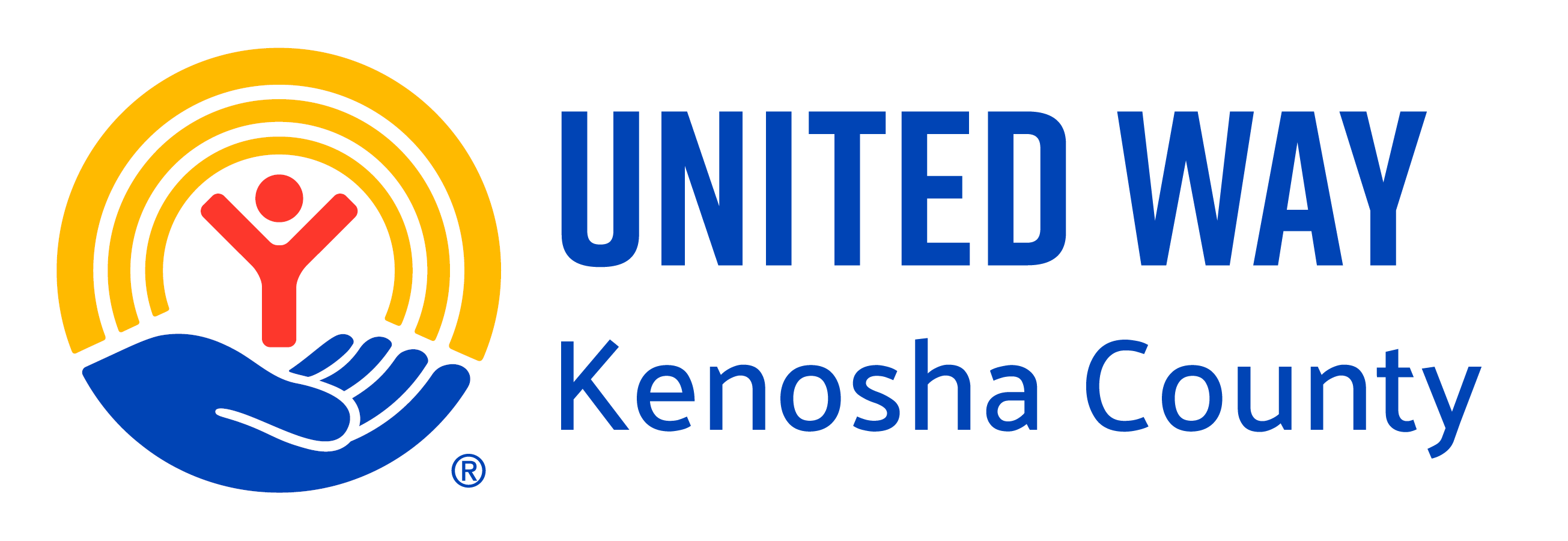
New ALICE report reveals that 58% of Wisconsin’s financially insecure veterans are rent burdened.
November 11, 2022 (Kenosha, WI) – They’ve served and sacrificed for our country yet over one tenth — 14% — of Kenosha County’s 10,149 veterans struggle to afford the basics, according to a new report from United Way of Kenosha County and its research partner United For ALICE. Statewide, more than one fifth — 21% — of Wisconsin’s 303,536 veterans live in financial hardship.
 In 2019, while 5% of the state’s veterans were deemed in poverty, 16% — 3 times as many — were ALICE (Asset Limited, Income Constrained, Employed). ALICE households earn more than the Federal Poverty Level but less than what it costs to live and work in the modern economy. Combined, 21% of Wisconsin’s veterans were below the ALICE Threshold of Financial Survival, with income that doesn’t meet the basic costs of housing, child care, health care, transportation and a smartphone plan.
In 2019, while 5% of the state’s veterans were deemed in poverty, 16% — 3 times as many — were ALICE (Asset Limited, Income Constrained, Employed). ALICE households earn more than the Federal Poverty Level but less than what it costs to live and work in the modern economy. Combined, 21% of Wisconsin’s veterans were below the ALICE Threshold of Financial Survival, with income that doesn’t meet the basic costs of housing, child care, health care, transportation and a smartphone plan.
“Our freedom comes with the responsibility to ensure that those who have served and sacrificed don’t struggle to make ends meet once they return home,” says Carolynn Friesch, CEO of United Way of Kenosha County. “Although veterans do have additional supports not afforded nonveterans, clearly there’s still room for improvement.”
In Kenosha County, The Department of Veterans Affairs (Federal), The Wisconsin Department of Veterans Affairs (State), County Veterans Service Officers (County Government) and Tribal Veterans Service Officers (Tribal Nation) work side by side to obtain VA benefits that veterans and their eligible dependents can benefit most from.
“Every year, various communities, including Kenosha, host events known as “Stand Down” to reach out to veterans who are homeless or at risk of becoming homeless,” says Ali Nelson, director of veterans services at Kenosha County Services and president of the County Veterans Services Officers Association of Wisconsin. “The event, which took place on November 5, aims to bring awareness to and assist veterans in filing for service-connected VA disability compensation benefits.”
The ALICE in Focus: Veterans report and interactive tools reveal that while veterans show lower rates of financial hardship than individuals who never served, in part due to the benefits that are available, our veterans still face tough financial hurdles.
For example, 37% of Wisconsin’s veterans earning below the ALICE Threshold spent more than 35% of their income on a mortgage, utilities, tax and insurance. That’s in comparison with 33% in Michigan and in Iowa. And for renters, Wisconsin had the second highest rate out of neighboring states (Iowa, Minnesota, Michigan, and Illinois) for struggling veterans being rent burdened at 58%.
In addition, just 17% of Wisconsin’s financially insecure veterans participated in the Supplemental Nutrition Assistance Program (SNAP), in comparison with 23% in Illinois and 19% in Iowa.
“Nonetheless, there are some lessons to be learned from this data,” says Stephanie Hoopes, Ph.D, director of United For ALICE National. “The state’s veterans are slightly better off than nonveterans with 21% struggling to make ends meet compared to 24% of adults who never served.”
“Veterans have higher rates of full-time employment, are more likely to be homeowners and have more comprehensive health insurance coverage and disability benefits,” says Hoopes. “This suggests that the supports afforded veterans are making a difference and could provide invaluable insights for developing strategies that help nonveterans facing financial hardship.”
“Veterans who meet the eligibility requirements for Federal and State VA benefits can submit applications to obtain VA benefits such as: compensation, pension, healthcare, home loan, and educational benefits as well as state level benefits such as property tax credits, WI GI Bill, and other veterans aid grants,” says Nelson. “The benefit that seems to be the most relied on of all the VA benefits is the VA compensation because veterans can receive monetary monthly payments for their service-connected conditions or injury based on a scale from 0 to 100 percent.”
_0.png) Other findings in Wisconsin from ALICE in Focus: Veterans include:
Other findings in Wisconsin from ALICE in Focus: Veterans include:
- Racial and ethnic inequities persist with 34% of Black veterans and 26% of veterans of two or more races living below the ALICE Threshold compared to 16% of white veterans and 13% of Asian veterans.
- Veterans with disabilities also struggled more to afford the basics — 32% — compared to 16% of veterans without disabilities.
- Among veterans with disabilities, there were also differences in financial hardship by race/ethnicity: 8% of Asian veterans, 13% of Hispanic veterans, 31% of American Indian/Alaska Native veterans, 32% of White veterans, 44% of veterans of two or more races, and 49% of Black veterans with disabilities were below the ALICE Threshold.
- While working, veterans still experience financial hardship with 7% of veterans with full-time employment living below the ALICE Threshold and 23% of veterans working part time.
- Of veterans who graduated high school but had not completed post-secondary education, 24% were living below the ALICE Threshold.
More data is available through the ALICE in Focus: Veterans interactive data dashboard, which provides filters for regional and local geographies, age, race, disability status, living arrangements, work status and proximity to military bases. Visit UnitedForALICE.org/Focus-Veterans. To explore more Kenosha County and Wisconsin ALICE reports, visit: www.kenoshaunitedway.org/ALICE.
ALICE in Focus: Veterans marks the third installment in the ALICE in Focus Research Series, which draws from the U.S. Census Bureau’s American Community Survey (ACS) Public Use Microdata Samples (PUMS). Each installment in the series highlights a specific segment within the ALICE demographic. The other installments focused on children and people with disabilities.
About UWKC
United Way of Kenosha County fights for the health, education, and financial stability of every person. For almost 100 years, UWKC has created positive change throughout Kenosha County by mobilizing the caring power of the community, improving lives, and striving for lasting, positive transformation. Through partnerships and collaborations, UWKC both supports local initiatives with an annual community investment process and manages programs such as Readers are Leaders, Volunteer Income Tax Assistance, SingleCare Prescription Discounts and more.
About United For ALICE
United For ALICE is a driver of innovation, research and action to improve life across the country for ALICE (Asset Limited, Income Constrained, Employed) and for all. Through the development of the ALICE measurements, a comprehensive, unbiased picture of financial hardship has emerged. Harnessing this data and research on the mismatch between low-paying jobs and the cost of survival, ALICE partners convene, advocate and collaborate on solutions that promote financial stability at local, state and national levels. This grassroots ALICE movement, led by United Way of Northern New Jersey, has spread to 24 states and includes United Ways, corporations, nonprofits and foundations in Arkansas, Connecticut, Delaware, Florida, Hawai‘i, Idaho, Illinois, Indiana, Iowa, Louisiana, Maryland, Michigan, Mississippi, New Jersey, New York, Ohio, Oregon, Pennsylvania, Tennessee, Texas, Virginia, Washington, Washington, D.C., West Virginia and Wisconsin; we are United For ALICE. For more information, visit: UnitedForALICE.org
